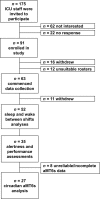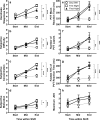The Impact of Shift Work on Sleep, Alertness and Performance in Healthcare Workers
- PMID: 30874565
- PMCID: PMC6420632
- DOI: 10.1038/s41598-019-40914-x
The Impact of Shift Work on Sleep, Alertness and Performance in Healthcare Workers
Abstract
Shift work is associated with impaired alertness and performance due to sleep loss and circadian misalignment. This study examined sleep between shift types (day, evening, night), and alertness and performance during day and night shifts in 52 intensive care workers. Sleep and wake duration between shifts were evaluated using wrist actigraphs and diaries. Subjective sleepiness (Karolinska Sleepiness Scale, KSS) and Psychomotor Vigilance Test (PVT) performance were examined during day shift, and on the first and subsequent night shifts (3rd, 4th or 5th). Circadian phase was assessed using urinary 6-sulphatoxymelatonin rhythms. Sleep was most restricted between consecutive night shifts (5.74 ± 1.30 h), consecutive day shifts (5.83 ± 0.92 h) and between evening and day shifts (5.20 ± 0.90 h). KSS and PVT mean reaction times were higher at the end of the first and subsequent night shift compared to day shift, with KSS highest at the end of the first night. On nights, working during the circadian acrophase of the urinary melatonin rhythm led to poorer outcomes on the KSS and PVT. In rotating shift workers, early day shifts can be associated with similar sleep restriction to night shifts, particularly when scheduled immediately following an evening shift. Alertness and performance remain most impaired during night shifts given the lack of circadian adaptation to night work. Although healthcare workers perceive themselves to be less alert on the first night shift compared to subsequent night shifts, objective performance is equally impaired on subsequent nights.
Conflict of interest statement
Ms Ganesan has no conflicts to declare. Dr Magee serves as a Project Leader in the Cooperative Research Centre (CRC) for Alertness, Safety and Productivity. Ms Stone, Ms Mulhall and Ms Collins have no conflicts to declare. Dr Howard serves as a Theme Leader in the CRC for Alertness, Safety and Productivity, which funded this work; and has received grants from Prevention Express and TEVA, which are not related to the work reported in this paper. Dr. Lockley is a Program Leader for the CRC for Alertness, Safety and Productivity, Australia, which funded this work. He has had a number of commercial interests in the last 2 years (2017–18) which are not directly related to the research or topic reported in this paper but, in the interests of full disclosure, are as follows: consulting fees from BHP Billiton, Consumer Sleep Solutions, Noble Insights, Pegasus Capital Advisors, and Team C Racing, and has ongoing consulting contracts with Akili Interactive, Apex 2100 Ltd., Headwaters Inc., Hintsa Performance AG, Light Cognitive, Lighting Science Group Corporation, Mental Workout, Six Senses, and Wyle Integrated Science and Engineering; has received unrestricted equipment gifts from Bionetics Corporation and F. Lux Software LLC; royalties from Oxford University Press; honoraria plus travel, accommodation or meals for invited seminars, conference presentations or teaching from BHP Billiton, Estee Lauder and Teague; travel, accommodation and/or meals only (no honoraria) for invited seminars, conference presentations or teaching from DIN and the Society for Light Treatment and Biological Rhythms; ongoing investigator-initiated research grants from F. Lux Software LLC; Dr. Lockley also holds a process patent for ‘Systems and methods for determining and/or controlling sleep quality’ which is assigned to the Brigham and Women’s Hospital per Hospital policy. Dr. Rajaratnam is also a Program Leader for the CRC for Alertness, Safety and Productivity, Australia, which funded this work. Dr. Rajaratnam reports grants from Vanda Pharmaceuticals, Philips Respironics, Cephalon, Rio Tinto and Shell, and has received equipment support and consultancy fees through his institution from Optalert, Tyco Healthcare, Compumedics, Mental Health Professionals Network, and Teva Pharmaceuticals, which are not related to this paper. Dr. Sletten serves as a Project Leader in the Cooperative Research Centre (CRC) for Alertness, Safety and Productivity.
Figures




References
-
- National Statistics Office. Shift employment in Malta 2015. 8 (Malta, 2015).
-
- Australian Bureau of Statistics. Working time arrangements. Report No. 6342.0, (Australia, 2012).
-
- Thompson, D. Healthcare just became the U.S.’s largest employer, https://www.theatlantic.com/business/archive/2018/01/health-care-america... (2018).
-
- Costa G. Factors influencing health of workers and tolerance to shift work. Theoretical Issues in Ergonomics Science. 2003;4:263–288. doi: 10.1080/14639220210158880. - DOI
Publication types
MeSH terms
Substances
LinkOut - more resources
Full Text Sources
Medical
Miscellaneous

